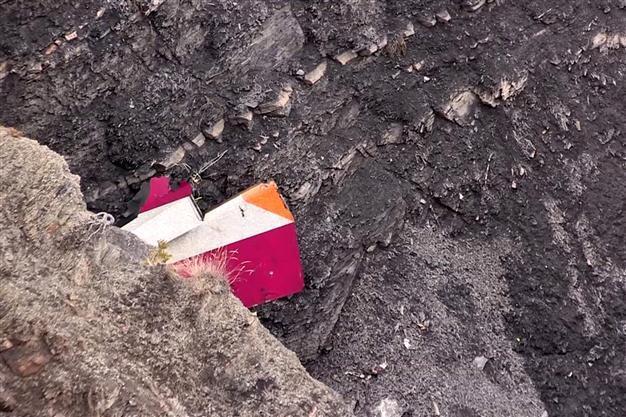Germanwings crash cannot be explained by plane's age: experts
PARIS - Agence France-Presse

A screen grab taken from an AFP TV video on March 24, 2015 shows part of the vertical stabilizer of the Germanwings Airbus A320 at the crash site in the French Alps above the southeastern town of Seyne. AFP Photo
The air disaster in the French Alps cannot be explained by the age of the Germanwings Airbus A320, which at 24-years-old should still have been in excellent condition, experts said Tuesday.Modern civilian aircraft are reaching the end of their career at a quarter-century, but should remain in perfect working order due to strict and regular maintenance checks.
The Airbus A320 that mysteriously crashed on Tuesday, killing 150 people, first entered service in 1991, according to Germanwings head Thomas Winkelmann.
That made it one of the oldest A320s in operation, since the first rolled off production lines in 1988.
But modern aircraft "can fly for 40 years without a single problem as long as they are well maintained," said Xavier Tytelman, an expert on aviation security who works at the France-based Centre for the Treatment of Fear of Flying.
"Twenty-five years old is not old for an aircraft."
Some companies outside the European Union push their planes right up to the four-decade limit, and beyond.
IranAir is still using Boeing 747-200 aircraft, according to its website, which were bought by the Shah in the 1970s, in spite of an embargo on parts from the United States after the 1979 revolution.
The Lockheed Tristar, last built in 1984, is still used by charter companies in Asia.
And it's not only the general public riding in ageing planes -- the Air Force One used by the US president is actually a Boeing 747 that is a quarter-century old.
Connoisseurs have kept much older aircraft in service, such as the antique Douglas DC-3 Dakotas, built in the 1930s and 1940s, which still operate regular passenger flights in northern Canada. The fleet of US carrier Delta Airlines has an average age of 16.9 years, according to its website, including 117 MD-88s with an average age of 24.2 years.
They are in their last years of commercial service, said Jean-Paul Troadec, former director of France's Bureau of Investigation and Analysis for Civil Aviation Security, but more for economic rather than technical reasons.
"If a plane is considered too old, it's because its fuel consumption has become less efficient than more recent planes," he said.
More modern models, such as the Airbus A320neo and Boeing 737 MAX, sell themselves on the amount of petrol they guzzle.
Regardless of their age, planes are subject to rigorous maintenance checks, with some 40,000 man-hours spent on them for every five years of service.
"The unit is effectively torn down and rebuilt" at every major maintenance overhaul, said Bertrand Mouly-Aigrot, of Archery Strategy Consulting, a air transport specialist.
"These are very rigorous and detailed operations," he said, allowing the plane to be used for a long time afterwards and requiring a green light from civil aviation authorities.
The head of Germanwings said Tuesday the accident could not be explained since the A320 had been through precisely one of these major maintenance overhauls, known as a "Type C", less than two years ago.
















